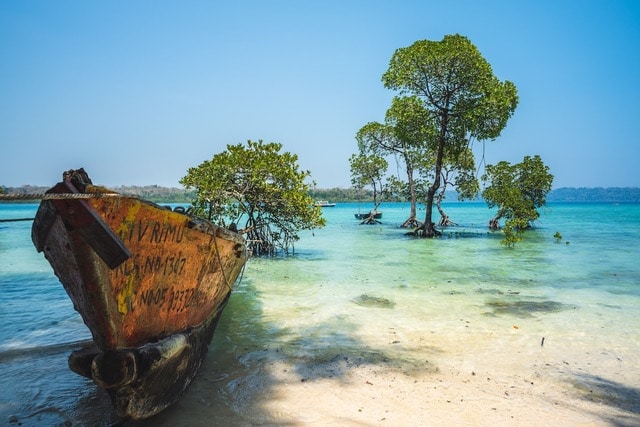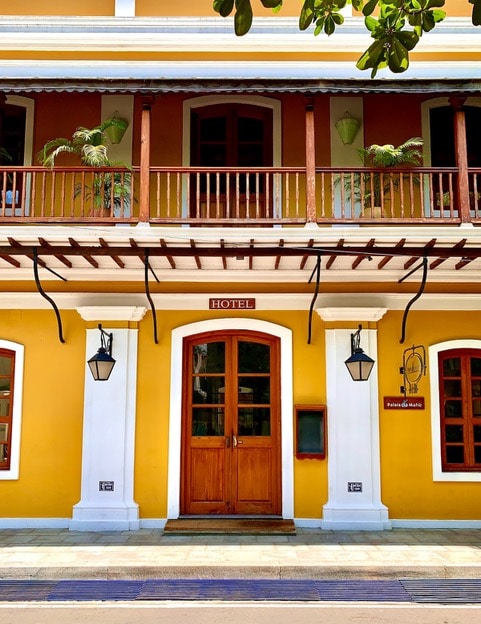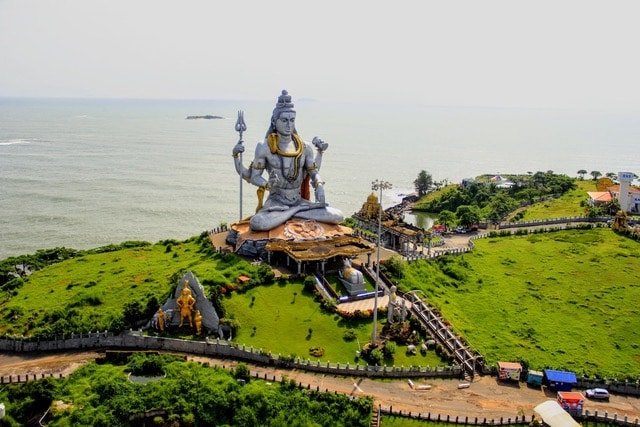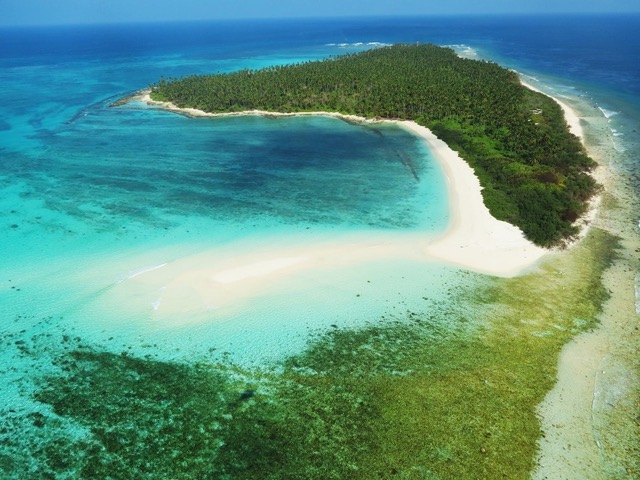News
Scuba Diving in India: 5 Best Places to Visit Now
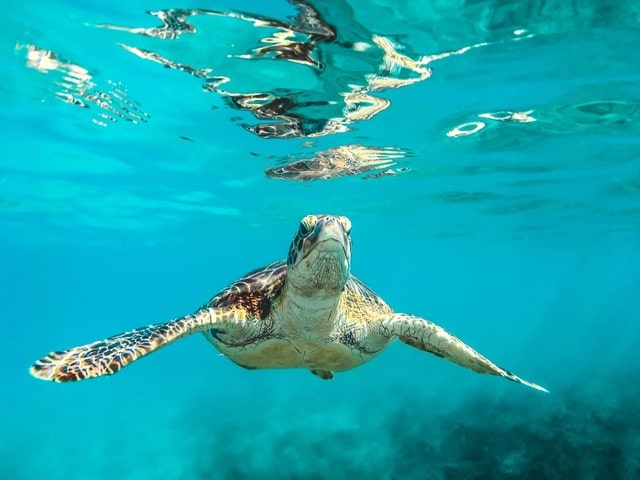
India doesn’t get the attention it deserves for its scuba diving. With its white-sand beaches and tropical islands, this stunning country is on a par with some of the world’s best-loved diving hotspots. There are isolated coral reefs, shipwrecks, pinnacles, remote atolls, and walls that host an eye-popping array of Indian Ocean marine life. With India recently opening its borders to fully vaccinated travelers, now is the time to explore this incredible destination before the rest of the world finds out.
- Andaman and Nicobar Islands.
The Andaman Islands sit off the coast of India in the Bay of Bengal, surrounded by bright blue waters and fringed with isolated coral reefs. It is a tropical paradise destination with thriving mangroves that support diverse marine life and extraordinary birdlife.
Many of these beautiful islands are inhabited by the Andamanese, an indigenous group of people whose privacy is paramount, meaning you cannot visit all of the islands. Some of the Andamanese tribes, such as the Sentinelese, have had little to no contact with the outside world for many years.
Havelock Island and Neil Island are two of the most exceptional diving spots in the Andaman Islands and are regularly rated as two of the best places for scuba diving in India.
Havelock has excellent macro diving, whilst Neil Island offers pristine coral reefs and fewer divers. Together they host some of the best marine life that the northern Indian Ocean has to offer.
When to go: November to April.
- Goa
Sitting on the west coast of India by the Arabian Sea, Goa is known for its long stretches of golden sands and lively nightlife. But if you step back from the bustling bars, you will find picturesque dive sites and a destination rich in culture and history.
Grande Island is a hotspot for water sports and is one of Goa’s best dive locations. There are dive sites for every level of diver at this must-visit island, plus some of Goa’s famous shipwrecks.
As an important trading port for centuries, Goa has around 100 shipwrecks off its shores, which have become thriving artificial reefs. As well as wrecks galore, Goa also has shallow coral gardens and striking pinnacles that attract tourists to Goa scuba diving every year.
When to go: October to May.
- Puducherry
Puducherry’s crystal-clear waters are enough to attract any keen diver to explore this well-known French colonial settlement and the surrounding area.
Above water, Puducherry is a quaint destination with a French Quarter of bougainvillea-lined streets, colorful colonial villas, and sophisticated boutiques.
Below water is equally as eye-catching, with a huge range of diving opportunities along Puducherry’s vast coastline. There are unexplored coral reefs and shipwrecks, plus famous dive sites such as Coral Sharks Reef – a great novice dive site with plenty of reef sharks.
Go in search of sea snakes at Aravind Wall, one of the most famous dive sites in India, explore popular Four Corners, or head into the deep, dark depths at The Hole.
When to go: February to April, September to November.
- Netrani Island, Karnataka.
Netrani Island (Pigeon Island) is one of India’s best-known dive spots and sits off the famous temple town of Murdeshwar. Shaped like a heart, it is also known as ‘the heart of India’s diving’ and offers world-class diving with excellent conditions.
There are rarely any currents at Netrani’s dive sites, making it an ideal destination for Open Water Divers and novices who want to learn to dive.
Most of the diving is done from boats, taking you to explore diverse coral landscapes bursting with colorful marine life. Keep an eye on the blue when you dive there, as whales sometimes visit this special island.
When to go: October to May.
- Lakshadweep
Lakshadweep, an archipelago off Kerala, has 36 atolls and coral reefs, with lagoons full of life and pristine reefs. Whilst you cannot visit all of the islands, those that you can visit make it a fantastic place to dive. And when you’ve had your fill of diving, you can explore Kerala’s famous tea plantations.
Whichever islands you choose, the clear blue waters of Lakshadweep have a seemingly endless list of marine life highlights, including sharks and sea turtles.
Bangaram Atoll is entirely surrounded by coral reefs and the continuous nature of the reef makes it one of the most interesting places to dive at Lakshadweep. As well as gorgeous corals, Bangaram hosts Princess Royal, a famous 200-year-old shipwreck.
Kadmat Island, or Cardamom Island, is all about turquoise waters, white sand beaches and encounters with numerous sea turtles. With healthy seagrass beds and coral reefs to dive, it is a mecca for marine life. Make sure you leave time to visit this impossibly idyllic island.
When to go: October to May.
Who is diving in India suitable for?
With over 8000 kilometers of coastline, India has a broad range of dive destinations to suit every dive experience level. There are plenty of easy-going dive sites for novices, plus adventurous dives for experienced divers.
What marine life will you see when diving in India?
Sitting in the Indian Ocean, India’s dive sites host a huge variety of life, including abundant tropical reef fish, lion fish, moray eels and prized critters. Sea turtles are regularly spotted cruising the reefs and nest at many of India’s islands. Manta rays, whales and dolphins are also seen in India’s waters.
Kathryn Curzon, a shark conservationist and dive travel writer for Scuba Schools International (SSI), wrote this article.
Blogs
Northern Red Sea Reefs and Wrecks Trip Report, Part 2: Wall to Wall Wrecks

Jake Davies boards Ghazala Explorer for an unforgettable Red Sea diving experience…
The second day’s diving was a day full of wreck diving at Abu Nuhas, which included the Chrisoula K, Carnatic, and Ghiannis D. The first dive of the day was onto the Chrisoula K, also known as the wreck of tiles. The 98m vessel remains largely intact where she was loaded with tiles which can be seen throughout the hold. The stern sits at 26m and the bow just below the surface. One of the highlights of the wreck is heading inside and seeing the workroom where the machinery used for cutting the tiles are perfectly intact. The bow provided some relaxing scenery as the bright sunlight highlighted the colours of the soft coral reef and the many reef fish.

Following breakfast, we then headed to the next wreck, which was the Carnatic. The Carnatic is an 89.9m sail steamer vessel that was built in Britain back in 1862. She ran aground on the reef back in 1869 and remains at 27m. At the time, she was carrying a range of items, including 40,000 sterling in gold. An impressive wreck where much of the superstructure remains, and the two large masts lay on the seafloor. The wooden ribs of the hull provide structures for lots of soft corals, and into the stern section, the light beams through, bouncing off the large shoals of glass fish that can be found using the structure as shelter from the larger predators that are found outside of the wreck.

The final wreck at Abu Nuhas was the Ghiannis D, originally called ‘Shoyo Maru,’ which was 99.5m long and built in Japan back in 1969 before becoming a Greek-registered cargo ship in 1980. The ship then ran aground on the reef on April 19th, 1983, and now sits at the bottom at a depth of 27m. Heading down the line, the stern of the ship remains in good condition compared to the rest of the hull. The highlight of the wreck, though, is heading into the stern section and down the flights of stairs to enter the engine room, which remains in good condition and is definitely worth exploring. After exploring the interior section of the ship, we then headed over to see the rest of the superstructure, where it’s particularly interesting to see the large table corals that have grown at the bow relatively quickly considering the date the ship sank. After surfacing and enjoying some afternoon snacks, we made sure everything was strapped down and secured as we would be heading north and crossing the Gulf of Suez, where the winds were still creating plenty of chop.

The next morning, it was a short hop to Ras Mohammed Nature Reserve for the next couple of days of diving. The 6am wake-up call came along with the briefing for the first site we would be diving, which was Shark & Yolanda. The low current conditions allowed us to start the dive at Anemone City, where we would drift along the steep, coral-filled wall. These dives involved drifts, as mooring in Ras Mohammed wasn’t allowed to protect the reefs. As a dive site, Shark & Yolanda is well-known and historically had a lot of sharks, but unfortunately not so many in recent years, especially not so early in the season. However, there was always a chance when looking out into the blue.

The gentle drift took us along the steep walls of the site, with plenty of anemone fish to be seen and a huge variety of corals. It wasn’t long into the dive before we were accompanied by a hawksbill turtle, who drifted with us between the two atolls before parting ways. Between the two reefs, the shallow patch with parts of coral heads surrounded by sand provided the chance to see a few blue-spotted stingrays that were mainly resting underneath the corals and are always a pleasure to see. With this being the morning dive, the early sunlight lit up the walls, providing tranquil moments. Looking out into the blue, there was very little to be seen, but a small shoal of batfish shimmering underneath the sunlight was a moment to capture as we watched them swim by as they watched us.

Towards the end of the dive, we stopped at the wreck of the Jolanda where the seafloor was scattered with toilets from the containers it was carrying. This provided a unique site to make a safety stop, which was also accompanied by a large barracuda slowly swimming by, along with a hawksbill turtle calmly swimming over the reef as the sun rays danced in the distance.
For the next dive, we headed north to the Strait of Tiran to explore the reefs situated between Tiran Island and Sharm El Sheik, which were named after the British divers who had found them. We started on Jackson before heading to Gordons Reef, where we also did the night dive. All the atolls at these sites provided stunning, bustling coral reefs close to the surface and steep walls to swim along, which always provided the opportunity to keep an eye out for some of the larger species that can be seen in the blue. Midwater around Jackson Reef was filled with red-toothed triggerfish and shoals of banner fish, which at times were so dense that you couldn’t see into the blue. Moments went by peacefully as we enjoyed the slow drift above the reef, watching these shoals swim around under the mid-afternoon sun.

The night dive at Gordon’s Reef was mainly among the stacks of corals surrounded by sand, which was great to explore under the darkness. After some time circling the corals, we came across what we were really hoping to find, and that was an octopus hunting on the reef. We spent the majority of the dive just watching it crawl among the reef, blending into its changing surroundings through changes in colour and skin texture. It’s always so fascinating and captivating to watch these incredibly intelligent animals, in awe of their ability to carry out these physical changes to perfectly blend into the reef. Before we knew it, it was time to head back to the boat to enjoy a well-deserved tasty dinner prepared by the talented chefs onboard.
Check in for the 3rd and final part of this series from Jake tomorrow!
To find out more about the Northern Red Sea reef and wrecks itineraries aboard Ghazala Explorer, or to book, contact Scuba Travel now:
Email: dive@scubatravel.com
Tel: +44 (0)1483 411590
Photos: Jake Davies / Avalon.Red
Marine Life & Conservation
Double Bubble for Basking Sharks

 The Shark Trust is excited to announce that, for two more days only, all donations, large or small, will be doubled in the Big Give Green Match Fund!
The Shark Trust is excited to announce that, for two more days only, all donations, large or small, will be doubled in the Big Give Green Match Fund!
Donate to Basking in Nature: Sighting Giants
The Shark Trust is hoping to raise £10k which will be doubled to £20k. This will go towards Basking in Nature: Sighting Giants. And they need YOUR help to reach they’re goal.
The Shark Trust’s citizen science project is to monitor and assess basking sharks through sightings; encouraging data collection, community engagement, and promoting nature accessibility. This initiative aims to enhance health and wellbeing by fostering a deeper connection with British Sharks.
Campaign Aims
- Increase citizen science reporting of Basking Sharks and other shark sightings to help inform shark and ray conservation.
- Provide educational talks about the diverse range of sharks and rays in British waters and accessible identification guides!
- Create engaging and fun information panels on how to ID the amazing sharks and rays we have on our doorstep! These can be used on coastal paths around the Southwest. With activities and information on how you can make a difference for sharks and rays!
- Promote mental wellbeing through increasing time in nature and discovering the wonders beneath the waves!
Donate, and double your impact. Click Here
-

 News3 months ago
News3 months agoHone your underwater photography skills with Alphamarine Photography at Red Sea Diving Safari in March
-

 News3 months ago
News3 months agoCapturing Critters in Lembeh Underwater Photography Workshop 2024: Event Roundup
-

 Marine Life & Conservation Blogs2 months ago
Marine Life & Conservation Blogs2 months agoCreature Feature: Swell Sharks
-

 Blogs2 months ago
Blogs2 months agoMurex Resorts: Passport to Paradise!
-

 Blogs2 months ago
Blogs2 months agoDiver Discovering Whale Skeletons Beneath Ice Judged World’s Best Underwater Photograph
-

 Gear Reviews2 months ago
Gear Reviews2 months agoGear Review: Oceanic+ Dive Housing for iPhone
-

 Marine Life & Conservation2 months ago
Marine Life & Conservation2 months agoSave the Manatee Club launches brand new webcams at Silver Springs State Park, Florida
-

 News3 months ago
News3 months agoWorld’s Best Underwater Photographers Unveil Breathtaking Images at World Shootout 2023


